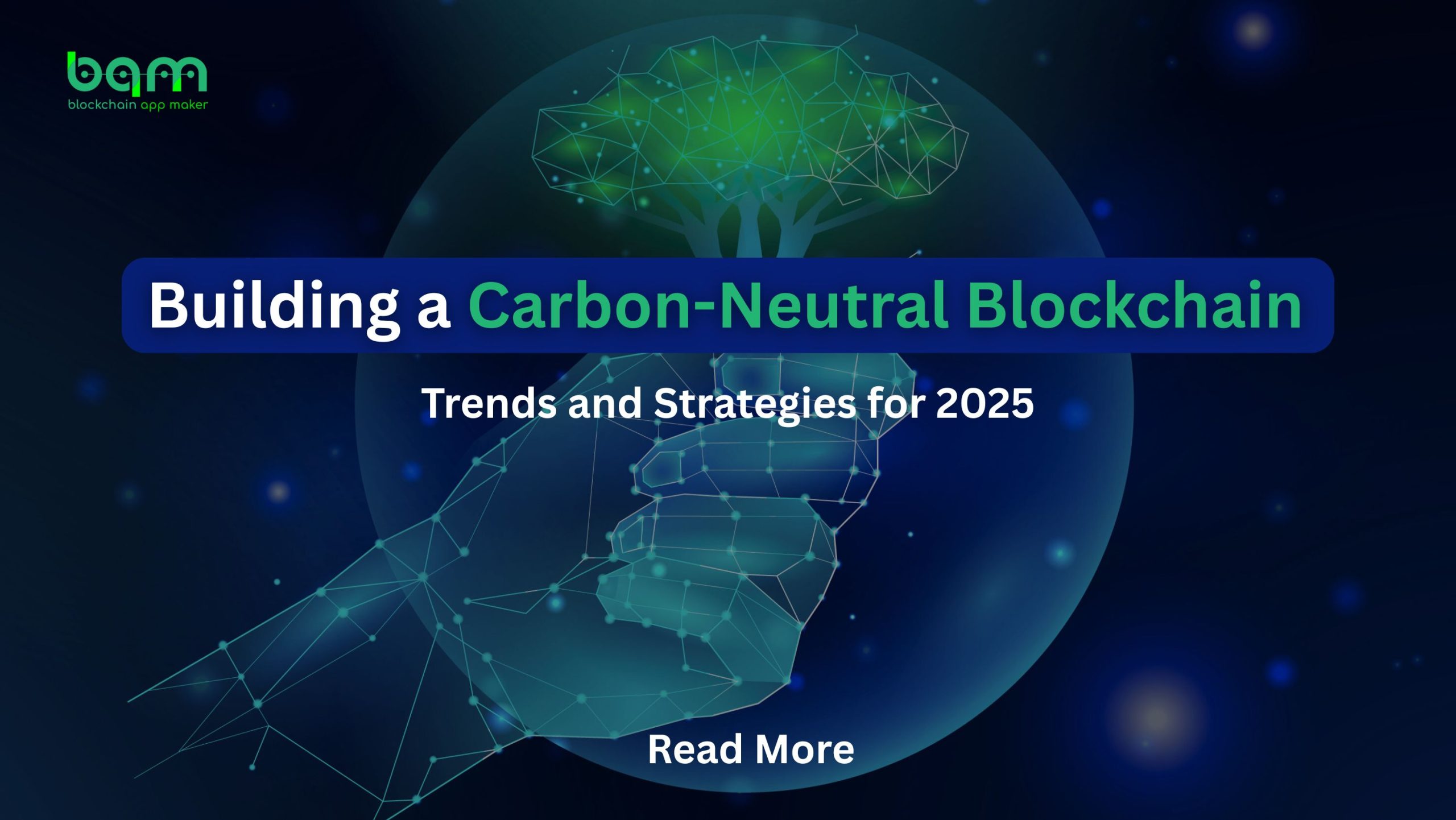Introduction: The Urgent Need for Green Blockchain Innovation
In the year 2025, the blockchain business is at a crucial point. As the use of distributed ledger technologies proceeds to transform industries, including finance, healthcare, supply chain, and gaming among others, there is increased pressure toward making a business build environmentally responsible blockchain systems.
Recent studies have revealed that the carbon emission generated by the blockchain industry is comparable to that of middle-sized countries, almost entirely because of consensus mechanisms that require high power. However, innovative businesses, CTOs, and startups are currently pioneering a new regime of carbon-neutral, sustainable blockchain models in accordance with Environmental Social and Governance (ESG) objectives.
In this blog, we’ll explore the top trends shaping carbon-neutral blockchain development in 2025 and provide actionable strategies for building green, future-proof solutions—while staying competitive, compliant, and customer-trusted.
What Is Carbon-Neutral Blockchain Design and Why It Matters in 2025
With blockchain being a fundamental element of digital transformation in most industries, sustainable systems are not a choice anymore but a strategic focus. The progressive entrepreneurs within the fintech industry, including large-scale corporate networks, are acquiring a carbon-neutral concept of blockchain architecture.
Defining Carbon-Neutral Blockchain Design
Carbon-neutral blockchain design refers to building blockchain platforms that either eliminate or offset their entire carbon footprint. This involves a combination of:
- Energy-efficient consensus mechanisms (like Proof of Stake),
- Deployment in renewable-powered regions (hydro, wind, or solar),
- Optimized smart contract architecture that minimizes gas consumption,
- Real-time carbon tracking via oracles or APIs, and
- Certified carbon offsetting through platforms like Verra or Gold Standard.
With infrastructure and operations aligned to eco-friendly practices, not only can the business cut down on emissions but also meet changing ESG standards, as well as fill it with stakeholders who value sustainability.
Key Elements of a Carbon-Neutral Blockchain
A truly carbon-neutral blockchain integrates the following components into its design and deployment strategy:
- Choose energy-saving platforms: By using PoS-based systems, including Cardano, Algorand, or Tezos, you can save 100 times as much power as with PoW networks.
- Use renewable energy sources: Power nodes or validators in environmentally friendly data centres in more environmentally friendly regions such as Canada, Scandinavia or Singapore.
- Streamline on-chain logic: Optimise smart contract inefficiencies by minimising gas-heavy code and incorporate Layer 2 scalability solutions.
- Audit and trace emissions: Add on decentralized tools to track power consumption and produce real-time carbon emitted to keep records visible and trackable, as well as to comply with standards.
- Compensate unavoidable emissions: Buy and tokenize certified carbon credits to become genuinely carbon neutral.
In summary: To build a carbon-neutral blockchain in 2025, use energy-efficient platforms, deploy in clean energy zones, optimize smart contracts, integrate emission tracking, and offset any remaining carbon via certified credits.
Carbon-neutral blockchain explained simply:
A carbon-neutral blockchain offsets or eliminates its emissions using sustainable technology, efficient design, and verifiable carbon credits—making it eco-friendly and ESG-aligned.
The Carbon Footprint of Traditional Blockchains
It is essential to know what is at stake before delving into the strategies. Blockchains, and, in particular, Proof of Work blockchains, guzzle down gigantic amounts of electricity.
Key Environmental Challenges:
- Large consumption of energy (bitcoin needs over 120 TWh per year).
- Reliance on fossil fuel when mining in parts.
- Transparency deficiencies with respect to reporting on emissions.
- There are risks of non-compliance connected with increasing global regulations.
Global Trends Shaping Carbon-Neutral Blockchain in 2025
1. Adoption of Green Consensus Mechanisms
- Pow to Proof of Stake (PoS) and Delegated PoS (DPoS), and Proof of Authority (PoA).
- The merger that happened to Ethereum in 2022 reduced its energy consumption to below 1 percent, making a strong statement.
2. Renewable-Powered Blockchain Nodes
Deployment in increased in areas where clean energy is available such as:
- Canada (hydroelectric power)
- Scandinavia (wind and geothermal)(wind and geothermal)
- Singapore (solar grids)
3. Blockchain-Enabled Carbon Offsetting
- Carbon offset trading can be done using smart contracts.
- Verified carbon credits are being tokenized on platforms such as Toucan Protocol, KlimaDAO and Verra.
4. Carbon Tracking & ESG Integration
- APIs and oracles used to monitor the energy consumption in real-time and monitor the emissions made.
- Embedding of ESG dashboards and auditable sustainability reports by blockchain developers.
How to Build a Carbon-Neutral Blockchain: Step-by-Step Strategies
1. Select a Low-Emission Blockchain Platform
Select PoS-based or low amount of energy ecosystems:
- Cardano
- Tezos
- Algorand
- Solana
- Polygon
These platforms offer 10,000x less energy use compared to PoW networks.
2. Deploy in Clean Energy Regions
Deploy your blockchain nodes or validator infrastructure into geographies with:
- Prerogative in renewable energy
- Green data centers
- Grid visibility and emission certifications
3. Optimize Smart Contract Architecture
- Optimize the computational requirements by use of lean code
- Off-chain processing Implement
- Use Layer 2 to reduce on-chain congestion
4. Offset Emissions with Verified Carbon Credits
Form collaborations with climate registries like:
- Gold Standard
- Verra
- UN Clean Development Mechanism
Demonstrate carbon neutrality on chain using NFT receipts or smart certificate NFTs
5. Integrate Real-Time Emission Oracles
Consume APIs or decentralized oracles in feeding live statistics of:
- Energy per transaction
- Place of energy sources of validators
- Carbon offset tracking
How Blockchain App Maker Delivers Carbon-Neutral Solutions
Blockchain App Maker leads the American market in tailor-made blockchain production, assisting businesses in the production of sustainable, regulation-receptive, and environmentally friendly-compliant applications.
Our Green Technology Services are as follows:
- PoS-Based Blockchain Architecture
- Green Validator Node Deployment
- Carbon Footprint Dashboard Integration
- Smart Contract Optimization & Gas Efficiency
- Local and Global ESG Standard Compliance
Schedule a Free Consultation to audit your existing system or launch a carbon-neutral blockchain from scratch.
Conclusion: Lead the Green Tech Revolution
In the year 2025 and after, the converged innovation and sustainability concepts will determine whether the blockchain projects will succeed or not. With environmental rules getting more stringent and the pressure on ESG being pushed to the forefront, companies can no longer afford to ignore the eco-friendly status of their digital set up.
Adopting a carbon-neutral blockchain strategy is not just about compliance—it’s about leadership. It shows that you are dedicated to responsible innovation, it forges trust among investors and consumers and it puts your organization to the forefront of green technology.
As a startup experimenting with your first dApp or an enterprise deploying blockchain mission-critical architecture, the move to energy- and environmentally friendly systems is defined. Whether it comes to selecting the appropriate consensus mechanisms, or including the real-time emission tracking and offsetting systems, each solution is essential.
Blockchain App Maker delivers secure, scalable-and-sustainable, blockchain solutions to organizations worldwide, so they can be future-ready, now. Our expertise in green blockchain development ensures your platform not only performs but aligns with the world’s climate goals.
Ready to lead the next era of sustainable innovation?
Schedule a Free Consultation or Contact Our Experts to start building your carbon-neutral blockchain today.




